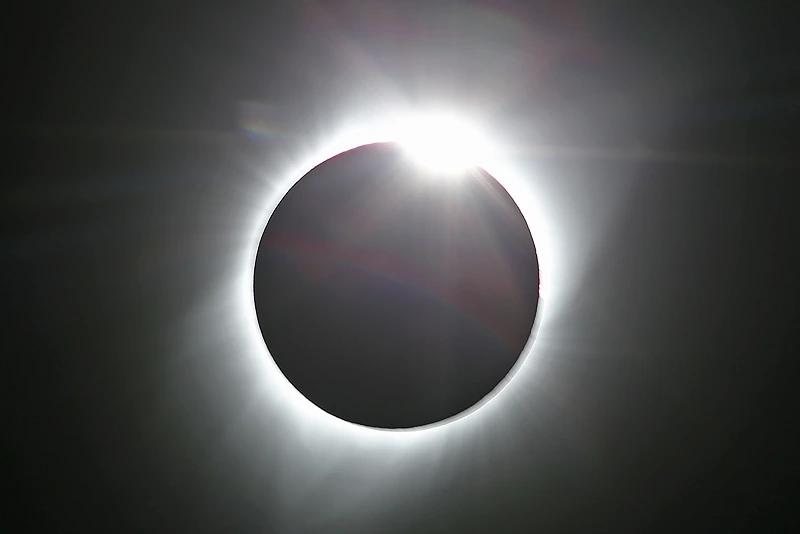
OAN’s Brooke Mallory
4:10 PM – Thursday, April 4, 2024
In order to better understand “how the Earth’s upper atmosphere is impacted when a section of the planet is darkened,” NASA plans to launch three sounding rockets on April 8th during the total solar eclipse.
The rocket launches will be a component of NASA’s Atmospheric Perturbations around Eclipse Path (APEP) project.
The project was named after the Egyptian god of chaos. “This campaign is named Apophis [another name for Apep] after the cosmic world serpent from ancient Egyptian cosmology. The serpent pursues the sun god Ra, and every so often, nearly consumes the sun disc, resulting in an eclipse,” a NASA website stated.
“Apep, also known as ‘Apophis’ in Greek, was the Egyptian god of chaos. Apep was the polar opposite of the godly personification of order, Ma’at, and the chief enemy of the king of the gods, the sun-god Ra. He took the form of a great snake,” according to study.com
This project aims to “measure disruptions in the Earth’s ionosphere caused by the Moon’s temporary eclipse of the Sun,” which is accomplished via sounding rockets that carry scientific instruments into key regions of space.
Additionally, on the same day, CERN’s biggest and most potent particle accelerator in the world will smash protons together in an attempt to find any unseen particles (dark matter) that is covertly causing the cosmos to expand, according to the European Organization for Nuclear Research.
Since an eclipse lowers solar energy, which in turn lowers ionization levels and affects radio waves, these can disrupt communications on Earth.
“It’s an electrified region that reflects and refracts radio signals, and also impacts satellite communications as the signals pass through,” said Aroh Barjatya, mission leader and professor of engineering physics at Embry-Riddle Aeronautical University.
“Understanding the ionosphere and developing models to help us predict disturbances is crucial to making sure our increasingly communication-dependent world operates smoothly.”
Three predetermined times—45 minutes prior to, 45 minutes during, and 45 minutes following the maximum eclipse in Virginia—are anticipated for the rocket launch.
The scientists’ success in this effort is critical because the next total solar eclipse in the contiguous United States will not occur until 2044. New instruments have been fitted for this voyage, as the rockets were previously launched from New Mexico during an annular solar eclipse in October.
The previous mission enabled scientists to capture a “sharp reduction in the density of charged particles as the annular eclipse shadow passed over the atmosphere,” according to The National outlet.
“We saw the perturbations capable of affecting radio communications in the second and third rockets, but not during the first rocket that was before peak local eclipse,” said Barjatya.
“We are super-excited to relaunch them during the total eclipse, to see if the perturbations start at the same altitude and if their magnitude and scale remain the same.”
In order to monitor the density of charged and neutral particles as well as the surrounding electric and magnetic fields, the Apep rockets are anticipated to soar to a maximum height of 420 kilometers.
The launches are scheduled to commence at 10.30 p.m. UAE time on NASA’s website and YouTube channel, where they will be televised live. Mexico, parts of Canada, and the U.S. “from Texas to Maine” will all be able to see the eclipse.
On April 8th, at approximately 11:07 a.m. PDT (10:07 p.m. UAE time), the Pacific coast of Mexico will be the first to witness totality.
The eclipse’s path will subsequently pass through Texas and on into Oklahoma, Arkansas, Missouri, Illinois, Kentucky, Indiana, Ohio, Pennsylvania, New York, Vermont, New Hampshire, and Maine.
From southern Ontario, viewers in Quebec, New Brunswick, Prince Edward Island, and Nova Scotia will also be able to see the eclipse in Canada.
At 5:16 p.m. NDT (11:46 p.m. UAE time), it will leave mainland North America off the Atlantic coast of Newfoundland, Canada.
“Except during the brief total phase of a total solar eclipse, when the Moon completely blocks the Sun’s bright face, it is not safe to look directly at the Sun without specialized eye protection for solar viewing. Viewing any part of the bright Sun through a camera lens, binoculars, or a telescope without a special-purpose solar filter secured over the front of the optics will instantly cause severe eye injury,” NASA said.
Stay informed! Receive breaking news blasts directly to your inbox for free. Subscribe here. https://www.oann.com/alerts
What do YOU think? Click here to jump to the comments!
Sponsored Content Below

